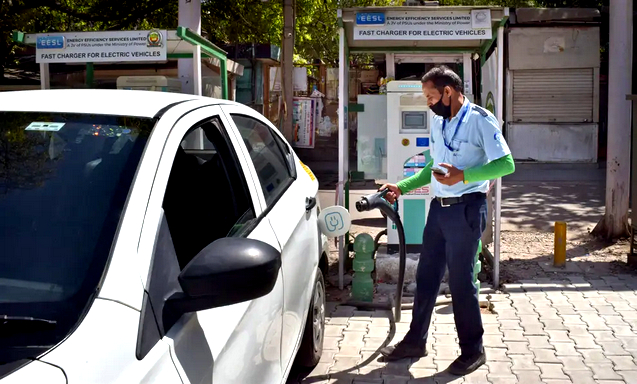
|
| Wodonga retiree Rod Clutterbuck wanted to do his bit to save the planet by buying an electric car. (ABC News: Richard Willingham) |
|
Key Points
|
The Andrews government will provide 20,000 subsidies of up to $3,000 for new electric vehicle purchases under $69,000, as part of a $100-million plan to encourage electric vehicle use.
The first 4,000 subsidies will be available from Sunday.
"When people get an EV (electric vehicle) they are starting to save significant dollars off their bills," Climate Change Minister Lily D 'Ambrosio told the ABC.
"It's almost up to $1,600 that is saved off fuel and maintenance costs, each and every year, so we want to make it easier for Victorians.''
As part of the package, the state will also spend $19 million on new charging stations and $10 million to expand the government EV fleet by 400 cars over the next two years.
The government will establish an expert advisory panel to advise it on the policies and infrastructure needed to meet the 50 per cent target by 2030.
"This is very, very ambitious but [a plan] we are absolutely committed to achieving,'' Ms D'Ambrosio said.

|
|
This is the cheapest all-electric car in the Australian market
which costs almost $44,000. (ABC News: Kristian Silva) |
The 2030 target and subsidies are part of the Andrews government's strategy for Victoria to have net zero emissions by 2050, with interim targets for 2025 and 2030 to be announced on Sunday.
Subsidies make EV cars a 'viable alternative'
Last year, the government failed to meet its own deadlines to set the interim emission reduction targets for 2025 and 2030.
Part of the interim targets policy are "sector pledges": policies and payments to help industries — including agriculture and transport — move towards net zero emissions.
The new electric car subsidy is part of the transport sector pledge. Transport is the second-largest emitter behind energy.
The take-up of electric vehicles in Australia has been slow compared to other developed nations, according to the Electric Vehicle Council, which said Australia lacked the type of incentives, including subsidies, available around the world.
The cheapest electric vehicle on the market is still more than $44,000.
In some countries, subsidies of up to $15,000 are available.
The Weekly electric cars
The council also said Australia was well behind other nations by not having tough fuel efficiency standards for cars.
Wodonga retiree Rod Clutterbuck has been looking to buy an electric vehicle for some time, to do his bit to "save the planet".
He said subsidies would help others view electric vehicles as a viable alternative.
"We've been wondering why we haven't had one [subsidy] in Australia. Now it sounds like we might be on the march to a better system,'' Mr Clutterbuck said.
Victoria slammed for new road tax
The announcement of the Victorian subsidy followed a coalition of car companies and environment groups slamming the Andrews government for having "the worst electric vehicle policy in the world" because of a new road tax on electric vehicles.
The new charge is 2.5 cent/km charge for electric and other zero-emission vehicles, including hydrogen vehicles, and a 2.0 cent/km for plug-in hybrid-electric vehicles.
The state argues the tax is an electric vehicle user's contribution to the road network, which is paid by other motorists through fuel excise.
Ben Warren, national manager of electrification and mobility for Nissan, said the subsidy and 2030 targets were a good "first step" to encouraging people to make the switch to electric vehicles.

|
|
The plan will include $19 million to build new charging stations
across the state.
(ABC: Ben Deacon) |
"But when you offset that with incentives and different measures it will at least get back to a neutral starting point.''
Opposition MP Georgie Crozier accused the government of coming up with incosistent policies on the spot.
"They're taxing you on one hand and providing a rebate on the other," she said."It just demonstrates that the government has really misjudged this policy again. It's another demonstration of policy on the run."
Treasurer Tim Pallas has previously said the revenue raised from the new charge would be "more than offset" by measures to encourage electric car use, such as creating new charging stations.
The road users charge was expected to raise about $30 million per year, with $45 million set aside for electric vehicle incentives in the state budget.
Mr Pallas said the subsidy would "encourage more drivers to consider purchasing a zero-emissions vehicle – and ensure Victoria leads the nation in zero-emissions vehicle uptake."
Links
- 'Worst electric vehicle policy in the world': Industry slams Victoria's proposed tax
- Calls for Victorian Government to set interim emissions reduction targets ahead of 2050
- Australians want electric vehicles, but car makers won't ship them here. Here's why
- Australia Lagging Behind On Electric Vehicles And Climate Action
- (AU) 'Do-Nothing Document': Australian Electric Vehicle Strategy Lets Emissions Keep Rising
- (AU) ACT Budget: $300m Climate Change Initiatives Unveiled
- (AU) Australia’s Electricity Market Must Be 100% Renewables By 2035 To Achieve Net Zero By 2050 - Study
- ABC News: Your Questions About Electric Cars Answered, As Federal Election Campaign Ramps Up




